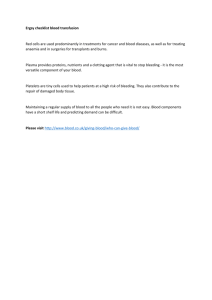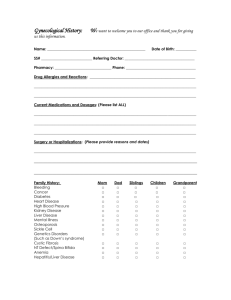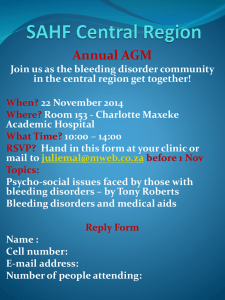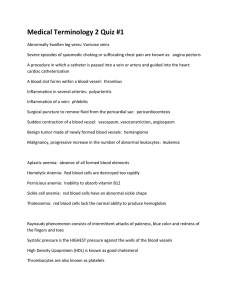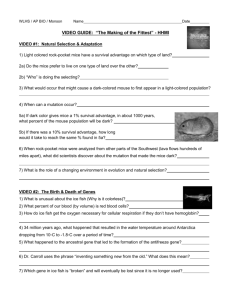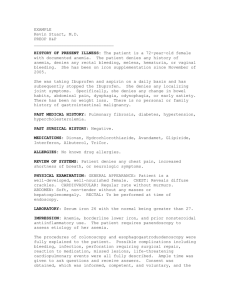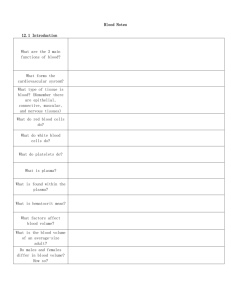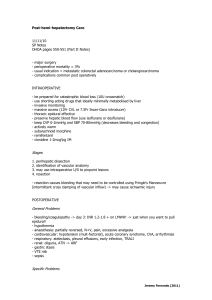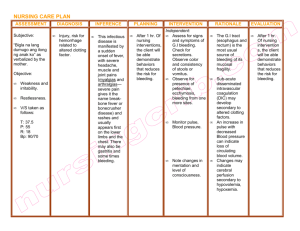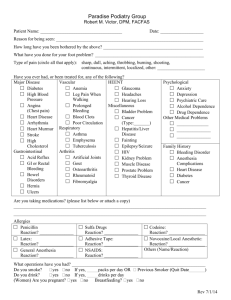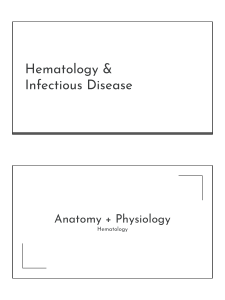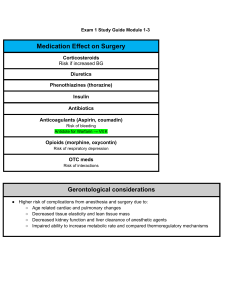BLOOD DISORDERS
advertisement
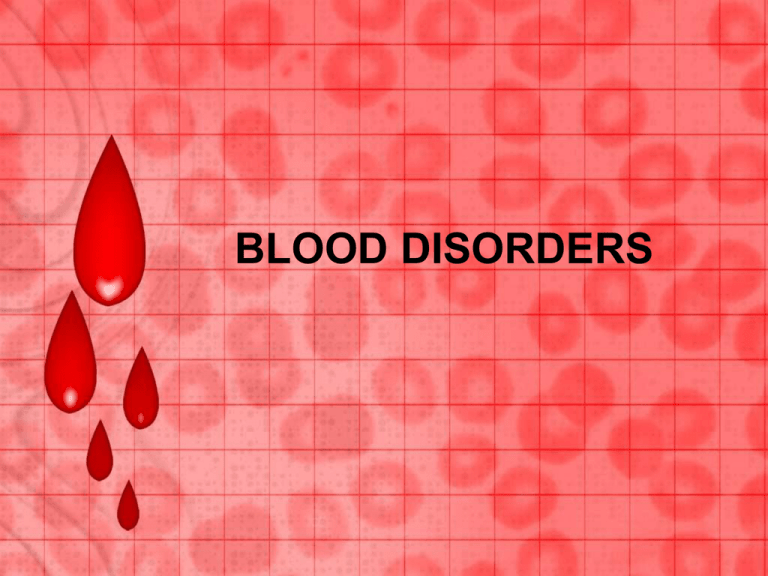
BLOOD DISORDERS HEMATOLOGY Study of blood in health and disease HEMATOLOGISTS STUDY: HEMATOLOGISTS STUDY: • • • • • Bone marrow Lymph nodes Spleen Hemostasis Thrombosis RED BLOOD CELLS HEMOGLOBIN + OXYGEN (FROM LUNGS) TRAVELS TO TISSUES THROUGHOUT THE BODY The Role of Red Blood Cells in Anemia ANEMIA MOST COMMON BLOOD DISORDER AFFECTS > 3,000,000 AMERICANS HEMOGLOBIN < 13.5 gm/dl (M) < 12.0 gm/dl (F) SYMPTOMS OF ANEMIA: • • • • • • • • Weakness Shortness of breath Fast/irregular heartbeat Pounding or “whooshing” in the ears Headache Cold hands/feet Pale/yellow skin Chest pain RISK FACTORS • • • • • • • • Poor diet Intestinal disorders Chronic diseases Infections Menstruation Pregnancy Age Vigorous athletic activity RISK FACTORS • • • • • • Rheumatoid arthritis Kidney disease Cancer Infections Liver disease Thyroid disease IRON-DEFICIENCY ANEMIA • Iron deficiency is very common • Women • People who have a diet that is low in iron • Vegans/vegetarians • Children who drink >16-24 oz./day of cow’s milk IRON-DEFICIENCY ANEMIA • Iron deficiency is very common • Women • People who have a diet that is low in iron • Vegans/vegetarians • Children who drink >16-24 oz./day of cow’s milk SICKLE CELL ANEMIA • Inherited blood disorder that causes the production of abnormal hemoglobin • RBCs are rigid and “C” shaped • get stuck and block blood flow pain/infections COMPLICATIONS OF SICKLE CELL ANEMIA • Result of blocked blood flow to specific organs • Stroke • Acute chest syndrome (condition that lowers O2 in the blood) • Organ damage • Other disabilities • Premature death The Problem With Sickled Cells RISK FACTORS • Sickle cell anemia is more common in certain ethnic groups, including: • People of African descent, including African-Americans (among whom 1 in 12 carries a sickle cell gene) • Hispanic–Americans from Central and South America • People of Middle Eastern, Asian, Indian, and Mediterranean descent BLEEDING DISORDERS • • • • Blood cannot clot properly Deficiency in clotting proteins Hemophilia Von Willebrand Disease SYMPTOMS OF BLEEDING DISORDERS • Easy bruising • Bleeding gums • Heavy bleeding from small cuts or dental work • Unexplained nosebleeds • Heavy menstrual bleeding HEMOPHILIA • Rare, typically inherited, bleeding disorder • Ranges from mild to severe, depending on how much clotting factor is present • Type A or Type B • based on which type of clotting factor is lacking • Results from a genetic defect found on the X chromosome RISKS • Any cut or injury can lead to excessive bleeding • Internal bleeding that can damage joints, organs, and tissues over time TREATMENT • Past: transfusions of factor VIII obtained from donor blood • early 1980s – these products were discovered to be transmitting bloodborne viruses, including hepatitis and HIV • Now – pure & safe • Improved screening techniques • Synthetic blood factors made in the laboratory by cloning the genes responsible for specific clotting factors BLOOD CANCERS • Affect the production and function of blood cells • Usually start in bone marrow where blood is produced BLOOD CANCERS • Normal blood cell development process is interrupted by uncontrolled growth of abnormal type of blood cell • Cancerous cells prevent blood from performing many of its functions • fighting off infections • preventing serious bleeding BLOOD CANCERS Cancer Cells vs. Healthy Cells LEUKEMIA • Found in your blood and bone marrow • Caused by rapid production of abnormal WBCs • not able to fight infection • impair ability of bone marrow to produce red blood cells and platelets LYMPHOMA • Affects lymphatic system • removes excess fluids from your body • produces immune cells • Lymphocytes (T-cells & B-cells) fight infection • abnormal lymphocytes become lymphoma cells • multiply and collect in your lymph nodes and other tissues • impair immune system MYELOMA • Targets plasma cells • white blood cells that produce diseaseand infection-fighting antibodies in the body • Myeloma cells prevent normal production of antibodies • body’s immune system weakened and susceptible to infection MALARIA • Infectious disease of humans and other animals caused by parasitic protozoans of the genus Plasmodium • Disease is transmitted via a bite from an infected female Anopheles mosquito • Protists travel to liver to mature and reproduce MALARIA • Symptoms typically include fever and headache (can progress to coma or death) • Widespread in tropical and subtropical regions in a broad band around the equator • Five species of Plasmodium can infect and be transmitted by humans • P. falciparum and P. vivax: vast majority of deaths • P. ovale, and P. malariae cause a generally milder form of malaria that is rarely fatal MALARIA • 2 phases • liver (exoerythrocytic phase) • infected mosquito pierces a person's skin • sporozoites in the mosquito's saliva enter bloodstream • migrate to the liver where they infect hepatocytes • multiply asexually and asymptomatically for 8–30 days MALARIA • Erythrocytes (erythrocytic phase) • escape (undetected) from liver to blood • infect RBCs • multiply further (asexually) • periodically break out of host cells to invade fresh RBCs MALARIA • Several such cycles occur • Classical descriptions of waves of fever arise from simultaneous waves of merozoites escaping and infecting RBCs MALARIA
